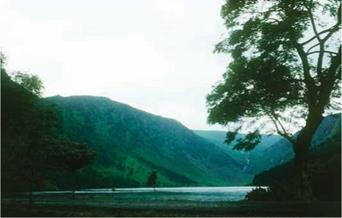The creation of usable, imaginative landscapes depends on how skillfully the designer applies the basic principles that guide all creative
planning.
Simplicity
Simplicity in the landscape can be either visual or physical, and is usually both. Simplicity usually dictates that separate elements be given less emphasis than massed elements, fussy bedlines be replaced with gentle curves or straight lines, and maintenance-free materials be used. By massing plant species into groups, attention is not diverted to each individual plant (Figure 9-10). In a similar fashion, the massing of colors is preferable to a salt-and-pepper mixture. Simplicity results when pools, patios, walks, and other constructions avoid complex shapes or forms that conflict with the overall shape of the outdoor room.
Rhythm and Line
Rhythm and line bring a feeling of continuity to the landscape. As bedlines flow between different use areas, the viewer’s eye should follow them comfortably without meeting jarring changes. By repeating the basic layout lines, colors, and materials throughout the landscape, the principle of rhythm and line is applied.
Balance
Balance is another visual quality of the landscape’s design. In theory, it puts the landscape on a seesaw and requires that each side have the same visual weight. There are three types of balance (Figure 9-11):
1. symmetrical, in which one side of the landscape is an exact duplicate (mirror image) of the other
2. asymmetrical, in which one side of the landscape has the same visual mass as the other but does not duplicate it
3.
 |
proximal/distal, in which the on-site landscape is developed to counterbalance the off-site landscape
figure 9-ю. Simplicity results from massing a limited selection of species in gently curvilinear beds. (Delmar/ Cengage Learning)
|
|
|
|
figure 9-11. Three types of balance; Top: Symmetrical, Center: Assymmetrical, Bottom: Proximal/Distel. (Delmar/Cengage Learning)
Balance cannot be developed from only one or two points within the landscape. It must exist from every important vantage point off the site and within it. For example, when viewed from across the street, the public area of a residence should frame the building, with the house as the center of attention. As the viewer gets closer, the entry door must be balanced with foundation plantings that warrant equal attention on both sides. Then, as the viewer stands at the door and looks back toward the street, the off-site view must balance against the on-site landscape.





